It’s been too long since the three people reading this were subjected to another vague, unspecialized, layman’s lecture on animals. Sadly, I run lower and lower on fuel with each I deliver, so you lucky sods are going to be privileged enough to hear me mindlessly repeat the exact same information I gave you in the bear attacks article. Yes, you have my permission to yell “woo,” and maybe stick your hands in the air as if you just do not care. Don’t say I’m not kind to you.
Bears are members of the Ursidae taxonomical family, with their closest living relatives being the members of the superfamily Pinnipedia – the earless seals, eared seals, and the walrus, which is left out of both groups and made fun of for having funny teeth.

There is nothing funny about these teeth.
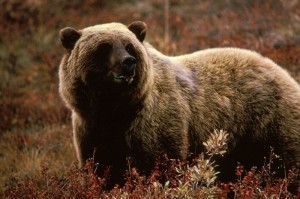
Note the family resemblance.
Bears are mostly omnivores, bar the giant panda (which eats bamboo, and is in danger of extinction) and the polar bear (which eats meat, and is rapidly becoming endangered). Aside from these two, the rest are pretty much willing to eat whatever, possibly for fear of being next on the line. Bears as a group share the following traits:
- Furry.
- Bulky.
- Like daylight for the most part, though if they’re raiding trash cans they’re smart enough to go for them at night.
- Mostly live in the northern hemisphere, except for the African Atlas bear (which we shot to death) the South American spectacled bear and Andes bear, and the Southeast Asian sun bear (none of which we’ve shot to death – yet).
At any rate, it’s time to move onwards and upwards. We’ll start off with a local favorite.
American Black Bear (Ursus americanus)
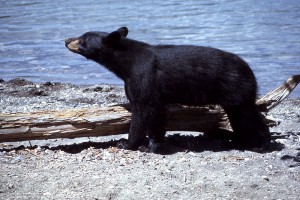
The graceful, roman nose of a black bear's profile is best appreciated when wedged inside your backpack looking for Snickers bars.
Well known as by far the most populous and generally widespread bear (or bahre, if you should so deem to call it) of North America, the black bear is both timid and tiny compared to the other local American: the grizzly. So, as said previously, it’s unlikely to attack you unless it’s trying to kill and eat you – a very encouraging thought, particularly since, like the grizzly, it mostly gets along on roots, berries, nuts, bugs, fish, eggs, and whatever else it feels like eating, such as that tasty, succulent pile of garbage some idiot camper carelessly left lying around. As a rule people prefer their bears timid and afraid of humans and therefore less likely to hang around their houses cozying up to them, something that’s hard for even the humblest of black bears to maintain when they’re scarfing our leftovers out of a camper or a car or a dumpster every evening. This gives one more excellent reason to be a responsible twit about your garbage, as opposed to an irresponsible twit, because those end up being the subject line of an article that contains the phrases “lacerations” “mauled” and “habituated” several times too many to be comforting.
Brown Bear (Ursus arctos)
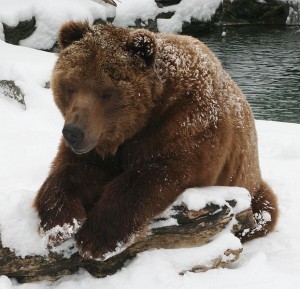
In formerly soviet territory of Kodiak, Alaska, teddy bear hugs YOU.
The brown bear is all over the place. Northern Eurasia, northern America – you name the vaguely chilly upper half of a continent that comes in close proximity to the Arctic circle and it’s there. As such, it varies quite a lot from place to place, especially on size. Bear bulk is already highly variable due to the issue of what time of year you’re weighing them (hibernation mass and all that), to say nothing of food supplies (coastal brown bears get so much good fish-food out of it that they outpace their landbound pals by a remarkable amount), but brown bears cover so much land that they’ve splintered into a beautiful grumpy, hirsute rainbow of bear subspecies that can range in number from ninety to five, depending on who’s asking. Genetically, however, they’re all quite similar. Size-wise, they can range from the Syrian brown bear, which isn’t much bigger than a black bear, to the alarmingly enormous Kodiak bear, which loses to polar bears in the “world’s largest land-based carnivore” competition solely on grounds of its decadently omnivorous lifestyle (also, although thinner, polar bears tend to be a bit longer and lankier).
Brown bears are overall more aggressive than black bears, seeing as they’re large and usually can’t climb trees, thus removing one line of defensive options and replacing them with “intimidate the epidermis out of anything that seems to threaten me.” So although brown bears (PARTICULARLY grizzlies) tend to go for people a lot more than black bears, a much greater percentage of the incidents are based around displaying how much bigger their bearsticles are than yours, and thus are free of predatory intent. Though this doesn’t preclude you getting eaten.
Giant Panda (Ailuropoda melanoleuca)
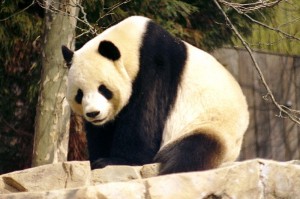
A panda pondering its inability to get it up. Every day of its life is like this, plus bamboo-binging.
The panda bear gets much hate – or at least disdain – for its famous lack of willingness to screw even when its entire species is on the line. Well mister smartass, let’s see YOU get raised in an alien environment surrounded by completely alien creatures and then get shoved into a room full of monitoring devices with a member of the opposite sex. You feel like getting it on? Do you? I thought not.
For all this, the Panda HAS bounced back quite a bit from its most desperate straits, and it’s getting a bit better at the whole “breeding” thing. They work out in terms of mass and size to be around the same size as very small brown bears, although they’re much less crotchety. Still, don’t hug them. Those claws are there, the muscles exist, and even though they only really eat bamboo, that doesn’t mean they’ll turn down fresh protein if it falls in their path. It’s mostly just bamboo, though – and since they aren’t running the most efficient plant-matter conversion gut in the world, they have to eat a lot of it. A lot. No, more than that. Like, tons. Constantly. Incidentally, the giant panda has a modified bone on its paw that creates a “thumb”-like protrusion, and has the second longest tail of all bears – four to six inches, as opposed to the epic 6-7 inch length of the Sloth bear. Hah, bet you thought you were going to get through this article without useless number-based trivia, didn’t you?
Polar Bear (Ursus maritimus)
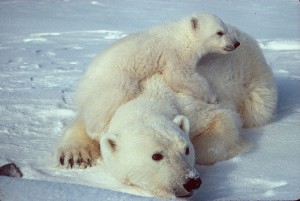
Despite their predatory instincts, polar bears love cubs, especially ones that aren't theirs, because those are edible.
The polar bear is the largest land-based carnivore in the world, so long as you discount the omnivorous Kodiak. Come to think of it, since polar bears can be quite comfortable over two hundred miles from land and can doggy-paddle at 6 mph comfortably for the entirety of it, perhaps they should be in the marine predator bracket, in which case they lose out to saltwater crocodiles, Nile crocodiles, many large sharks, killer whales, sperm whales, and a bunch of other things. Well, better a disputed title than none at all. They’re still the largest bears. Unless you count the Kodiak’s tendency to be slightly heavier and stubbier – but look, it’s close enough, okay? Quite being such a prick.
Polar bears are exceptional in many other ways – for one thing, they live in one of the earth’s harshest environments, yet still manage to find enough fuel to keep that big furry body efficient. There’s only so much heat loss you can cut out with the ol’ “shrink the size of the ears and thicken the fur” and so on, and a big body helps trap all that warmth inside your big guts, where it can’t escape. Still, that means you also have to find food to allow that big body to grow into maturity and keep ambling around with all those guts in it. Polar bear seal hunting involves long, long, long patient waits at ice holes found by the lingering traces seal’s terrible breath, followed by very quick bursts of violent skull-clubbing and yanking the seal up and out of the water. Even if the hole’s too small for the seal. Eurgh.
When it comes to humans, polar bears have none of the timidness of black bears and none of the surliness of browns. They’re confident. Of course, there’s decent odds they’ll kill you, but they’ll usually do it because they feel like eating something rather than tetchiness. Although this may be because very seldom is anything stupid enough to get in their faces and annoy them.
Picture Credits:
- California Sea Lion: Public domain image from Wikipedia; “Zak,” U.S. Navy sea lion, taken Jan 29 2003 by Photographer’s Mate First Class Brien Aho.
- Grizzly Bear: Public domain image from Wikipedia; Harry Watson, U.S. Fish and Wildlife Service.
- Black Bear: Public domain image from Wikipedia; Harlan Kredit, taken in Yellowstone National Park, 1976.
- Kodiak Bear: Public domain image from Wikipedia; David Pape, March 17th 2007, Buffalo Zoo.
- Giant Panda: Public domain image from Wikipedia; Jeff Kubina, March 2004, Smithsonian National Zoological Park.
- Polar Bear: Public domain image from Wikipedia; Schliebe, Scott, U.S. Fish and Wildlife Service.